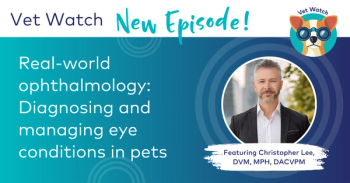
Vision in domestic animals (Proceedings)
"How well can my pet see?" is a common question pet owners pose to veterinarians.
"How well can my pet see?" is a common question pet owners pose to veterinarians. They almost universally assume that human vision is best. In the ways that laypeople mean the question, this is probably a fair statement. Though they may use other terms, clients are usually referring to visual acuity and "color vision," and humans are superior in both these regards. There are a number of other factors that contribute to functionality of vision, however, which will be discussed, including pupil shape, globe position, photoreceptor composition, and presence/ absence of tapetum. It is the lecturer's opinion that adaptations exist within species that allow them to function at their best- within their own environment and lifestyle. The dog, cat, and horse are used here to demonstrate these adaptations.
Visual acuity is used to describe the maximum resolving power of the eye, or ability to see detail. Its what optometrists measure when calculating your prescription. Emmetropia is the term used for normal visual acuity- hopefully the way you see when wearing your glasses or contact lenses. Ammetropic individuals are either near-sighted (myopic) or far-sighted (hyperopic). The common tests used to evaluate visual acuity in people record a value of 20:20 when emmetropia is present, which in simplest terms means that they can discern from 20 feet the detail that they should at that distance. People with 20:30 vision can only discern from 20 feet the sort of detail that a person with normal vision can from 30 feet. Since our patients cannot read- or communicate that they correctly read- an eye chart, this test becomes useless. Nonetheless, other means, including retinoscopy and mathematical formulas, have been used to estimate visual acuity in domestic animals. Horses are estimated to have acuity of about 20:33, dogs of 20:75, and cats of 20:100. In other words, these three species have vision that is hyperopic (near vision is relatively poor) when compared to human vision. However, they appear to have less individual variation in visual acuity (so most dogs are roughly emmetropic for dogs). This is advantageous to veterinary ophthalmologists, who can expect most of their patients of the same species to benefit substantially from placement of a standard artificial intraocular lens (IOL) after cataract extraction. The power of IOL required to return an average dog to emmetropia (41 Diopters) is different from that required for the cat (52 Diopters), however, because the contribution of the lens to vision varies among species.
Although the lens is very important for "fine focus vision," and lens replacement when possible has become standard in the veterinary ophthalmology community, it is important to note that eyes without lenses are not blind. In fact, the cornea is a much more important contributor to vision than the lens. Aphakic eyes are substantially hyperopic/far sighted (by 14 Diopters in the dog), so their near vision is blurry, but even bilaterally aphakic dogs without other substantial ocular abnormalities function very well. For an image to focus on the retina, roughly parallel light rays entering the eye must undergo a series of refractions to reach the appropriate retinal layers in very precise arrangement such that a sensible image can be sent to the brain for processing. In an individual with perfect vision, the light rays entering the eye converge at exactly the right level. With hyperopia (such as seen with aphakia), near images are formed behind the retina, while with myopia, far images form in front of the retina. In both cases, the affected images lack clarity and are seen with "fuzzy borders." The cornea is the most powerful refractive structure of the eye, while the lens is the second most important, and the vitreous is much less important. Opacities at any layer within the normally clear visual axis (cornea, aqueous, lens, vitreous) cause scatter of light rays, and degrade the quality of the image formed.
Retinal photoreceptor composition affects image quality and is in turn affected by lifestyle. Human beings have a cone-dominant retina and a highly cone-dense area called the macula which is critical for central visual acuity. The vast majority of domestic species have rod-dominant retinas and lack a macula. All photoreceptors absorb light and use it through a chemical reaction to form images. Rod photoreceptors are most important for vision in dim light, while cones are more important for animals functioning primarily in daylight conditions. Rod photoreceptors increase light detection under low light conditions. They provide improved sensitivity to light intensity changes, improved motion detection, and greater grey-scale discrimination. They provide relatively poor resolution. Cones, on the other hand, are important for high intensity vision, provide high resolution, rapid response, and color perception, but have a low sensitivity to subtle changes in light intensity. For these reasons rod-dominant retinas are advantageous to nocturnally oriented animals and dogs even appear able to distinguish more shades of grey than people. Cone-dominant retinas are beneficial by providing improved visual discrimination and color vision, which will be discussed shortly. Only primates have a true macula, a cone-rich circular area of the retina responsible for high acuity vision, although many species do have an area of increased cone density called a visual streak or area centralis, which is theorized to provide a similar, but less pronounced benefit in these animals. Dark adaptation describes the period of time in which rod photoreceptors become more sensitive to light when the ambient light intensity diminishes. This process continues for a longer period in animals with rod-dominant retinas.
Human color vision is normally trichromatic (based on three colors- red, blue, and green). This color spectrum in turn is based on the numbers and types of cones present. So people have three subsets of cones with peak absorptions corresponding to the wavelengths of light seen as the above colors. Completely color blind individuals are monochromats who have no ability to discriminate colors. Dogs and horses actually fall in between- they are dichromats with an altered color spectrum when compared to humans which is based on two subsets of cones. Their color spectrum is comparable to that of a human with sex-linked red-green color blindness. In both cases, red, yellow, and green are nearly indistinguishable. Evidence suggests that cats, in spite of their rod-dominant retinas, are weak trichromats, since three subsets of cones have been identified in this species. Because of their lower concentrations of cones, colors are likely seen as much less intense by rod-dominant individuals, however.
Many domestic animals have adaptations to improve their night vision. Although it is a myth that dogs/cats/horses see better at night, the negative effects of low light conditions are less pronounced in these species compared to humans due to these adaptations. A highly reflective layer called the tapetum is present just beneath the retina within the choroid of many species, including dogs, cats, and horses. It is responsible for the "eye shine" seen when headlights catch the eyes of a cat or dog- or deer. The tapetum is believed to enhance night vision by reflecting photons of light that have already passed through the retina back to reactivate the photoreceptors. Therefore, a lower threshold of light is required for light detection. In the highly nocturnally oriented cat, which has a correspondingly highly reflective tapetum, it is estimated to improve light detection up to seven times at night. In daylight situations, however, the tapetum may act to degrade images. Nocturnally oriented species, like the cat, may have slit shaped pupils. The cat's vertical slit pupil is highly efficient in its ability to rapidly constrict compared to the dog's round one, but also efficiently dilates to allow in more light at night. Efficient pupillary constriction acts to protect the retina during daylight and small pupils have the added benefit of improving depth of field under lighted conditions. The vertical slit pupil of the cat is also theorized to improve detection of horizontally oriented motion, while the horizontally oriented horse pupil may further enhance their peripheral vision, which is important for prey species. Corneas are typically larger in nocturnally oriented species as well, an adaptation to allow in more light.
Globe positioning also varies among species. When eyes are closer together, animals benefit from a greater degree of overlap of their visual fields, and, thus, improved stereopsis (depth perception), but this is at the expense of diminished total visual field. For example, humans have a large area of binocular overlap of about 124°, which results in good frontal depth perception. As a result, they also have a large blind spot of about 152° behind them. Horses, on the other hand, have a relatively small region of binocular overlap of about 65°, but have a nearly panoramic (357°) field of view. This allows this prey species to monitor for predators while grazing. It should be mentioned that this extreme peripheral vision is not high acuity vision, but acts primarily for motion detection. Dogs, cats, and other carnivores, fall in between humans and horses with respect to binocular overlap and total field of view. Combined, these species variations in microscopic and macroscopic ocular anatomy translate into benefits that suggest at least some evolutionary benefit. For examples, the widely placed globes of horses provide an extreme degree of peripheral vision useful for monitoring for dangerous predators while grazing and cats have a highly developed tapetum and rod-dominant retina which enhances their low light vision.
Newsletter
From exam room tips to practice management insights, get trusted veterinary news delivered straight to your inbox—subscribe to dvm360.






